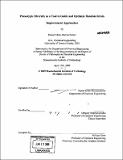Phenotypic diversity as a tool to guide and optimize random strain improvement approaches
Author(s)
Klein-Marcuschamer, Daniel
DownloadFull printable version (30.21Mb)
Other Contributors
Massachusetts Institute of Technology. Dept. of Chemical Engineering.
Advisor
Gregory Stephanopoulos.
Terms of use
Metadata
Show full item recordAbstract
A sustainable economy will depend, if only partly, on efficient renewable-feedstock conversion to chemicals and fuels, and advances in that direction have relied and will continue to rely on strain engineering. Traditional methods comprising directed genetic modifications (i.e. targeting specific genes) have been quite successful in improving several phenotypes of industrial interest. Evolutionary approaches have also contributed much to these efforts and are gaining attention in particular for addressing complex phenotypes. Most commonly, mutagenesis and selection has been the method of choice, but many other random search-based approaches for phenotypic alteration have been developed in recent years. One such method, transcriptional engineering, relies on transcriptome-wide modifications that can be exploited to better complex traits. The initial aim of this work was to build upon the idea of transcriptional engineering in bacteria, which had been tried in our laboratory through mutagenesis of the principal sigma factor, sigma D. Initially, we explored new targets for transcriptional engineering. Using error-prone PCR, we constructed libraries of several stress-related sigma factors in Escherichia coli (sigma S, sigma E, and sigma H) and screened them for phenotypes of interest. We also considered the alpha subunit of the RNA polymerase as a tool for phenotypic alteration, and fruitfully used it to improve butanol and solvent tolerance, accumulation of hyaluronic acid, and L-tyrosine production. (cont.) Carefull assessment of the sigma and alpha libraries for a few phenotypes revealed that not all the targets were equally useful, and that succeeding at improving one trait does not imply that the same target could be used to improve a different one. We also extended the use of the already-proven target, sigma D, to a new species, Lactobacillus plantarum. We constructed random mutagenesis libraries of this gene and produced a cell library that was selected in conditions relevant to the production of lactic acid. This chemical has attracted attention for its use as a food and pharmaceutical additive, and in the production of specialty chemicals and biodegradable plastics. We isolated two mutants with significantly higher growth rates in media acidified with both lactic and hydrochloric acid, one of which is also better at fermenting lactic acid at low pH. The mixed results obtained during our target search forced us to re-frame the question of what constitutes a useful library for phenotypic alteration. We hypothesized that the phenotypic diversity of a library could be quantified and used to evaluate the potential of different populations for strain improvement. After developing the conceptual framework to support it, we proposed a metric to estimate phenotypic diversity and showed that it correlates with the usefulness of a library with regard to finding an improved mutant. The metric, termed divergence, can be used to assess the potential of different targets, to prioritize and economize screening experiments, and, as we later proved, to optimize the construction of libraries. (cont.) The usefulness of evolutionary methods is often times muddled by the element of chance, and more so because failing to isolate an improved mutant does not suggest a modification to the experimental approach. With this in mind, we tested whether the divergence metric could be used to systematize the construction of new libraries when screening or selection of a previous library fails to deliver mutants improved for a trait of interest. We used the metric for successively modifying the alpha subunit library design until a mutant of interest was isolated. We showed that this effort increases the likelihood of finding desired clones, in our case, a butyrate-tolerant mutant that grows significantly faster in the presence of the toxic chemical compared to the wild-type. An optimized library, in which surface amino acids of the C-terminal domain of alpha were targeted for mutagenesis, was constructed by gathering the information about how modifications to the library design affected the resulting divergence. We repeated the approach with the sigma D libraries, and considerably enhanced the diversity by targeting regions 4.1 and 4.2 of this protein for mutagenesis. We used the novel sigma factor libraries to improve tolerance to the simultaneous stresses of overlimed bagasse hydrolysate and high concentrations of ethanol. Lastly, we explored the use of our divergence metric to study key determinants of regulatory proteins (residues, regions, structures, or functionalities) that have a high potential for altering phenotype. (cont.) We modified our divergence quantification protocol to test whether individual amino acids in the alpha subunit could be experimentally considered as determinants for diversity. We showed that not only can single residues be probed individually, but also that, by testing the phenotypic diversity produced by saturation mutagenesis at different positions, we could find regions and functionalities that are promising for further studies. We proposed this as a novel way for reducing the search space in a particular target for the purpose of increasing the quality of a library. What started as an effort to improve upon transcriptional engineering, soon evolved into a general approach to optimize random search-based methods for isolating traits of interest. We demonstrated the use of this approach for guiding the construction of transcriptional engineering libraries, and in addition outlined the conceptual framework for extending this work to any genetic library. As such, the work of this thesis served both theoretical and practical goals, and furthered the understanding of how evolution can be exploited in the laboratory
Description
Thesis (Ph. D.)--Massachusetts Institute of Technology, Dept. of Chemical Engineering, 2009. Includes bibliographical references (leaves 258-298).
Date issued
2009Department
Massachusetts Institute of Technology. Department of Chemical EngineeringPublisher
Massachusetts Institute of Technology
Keywords
Chemical Engineering.